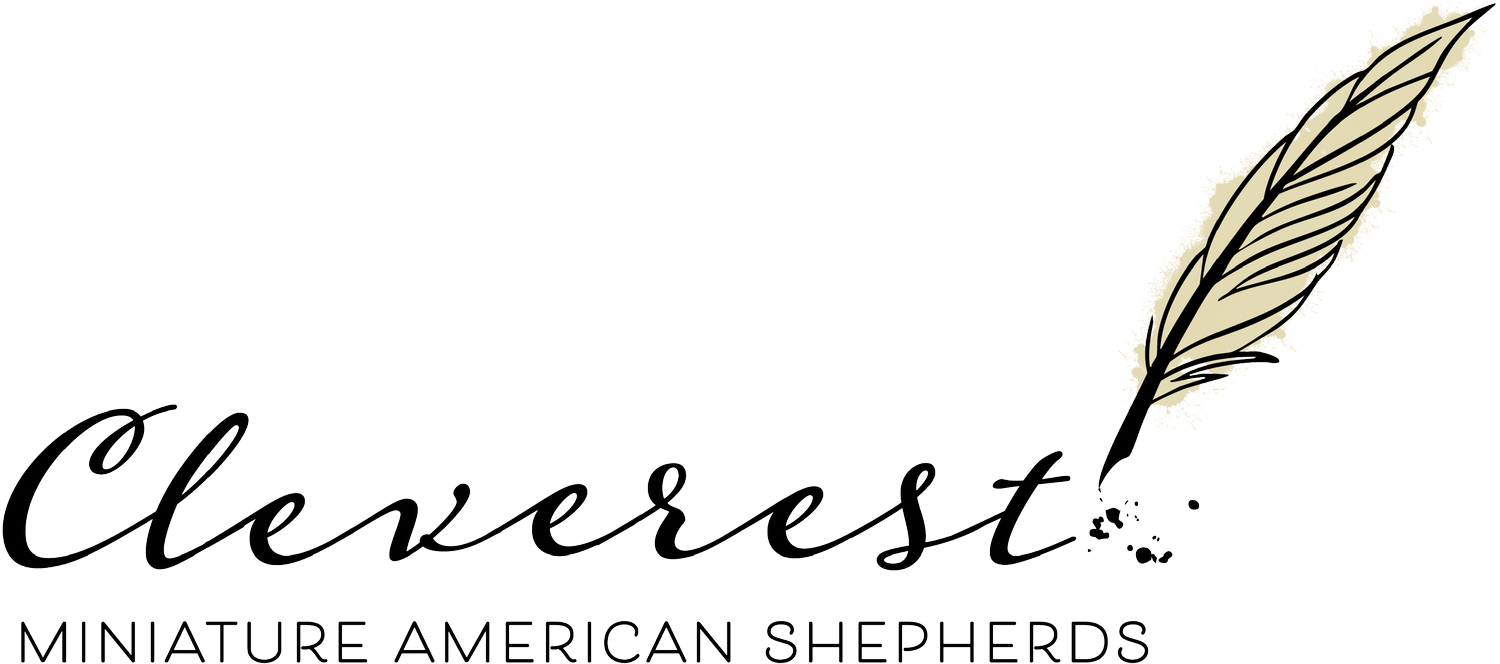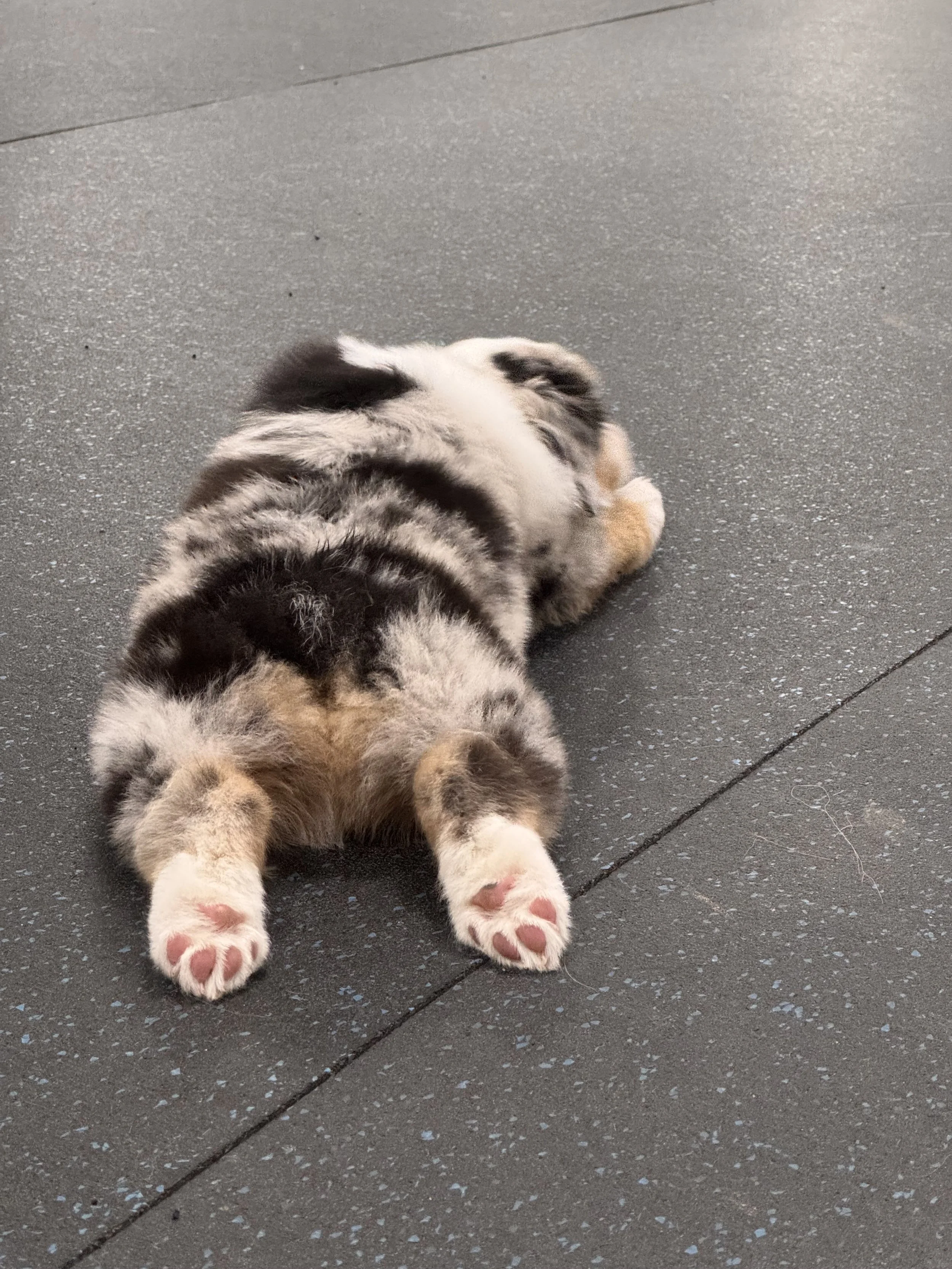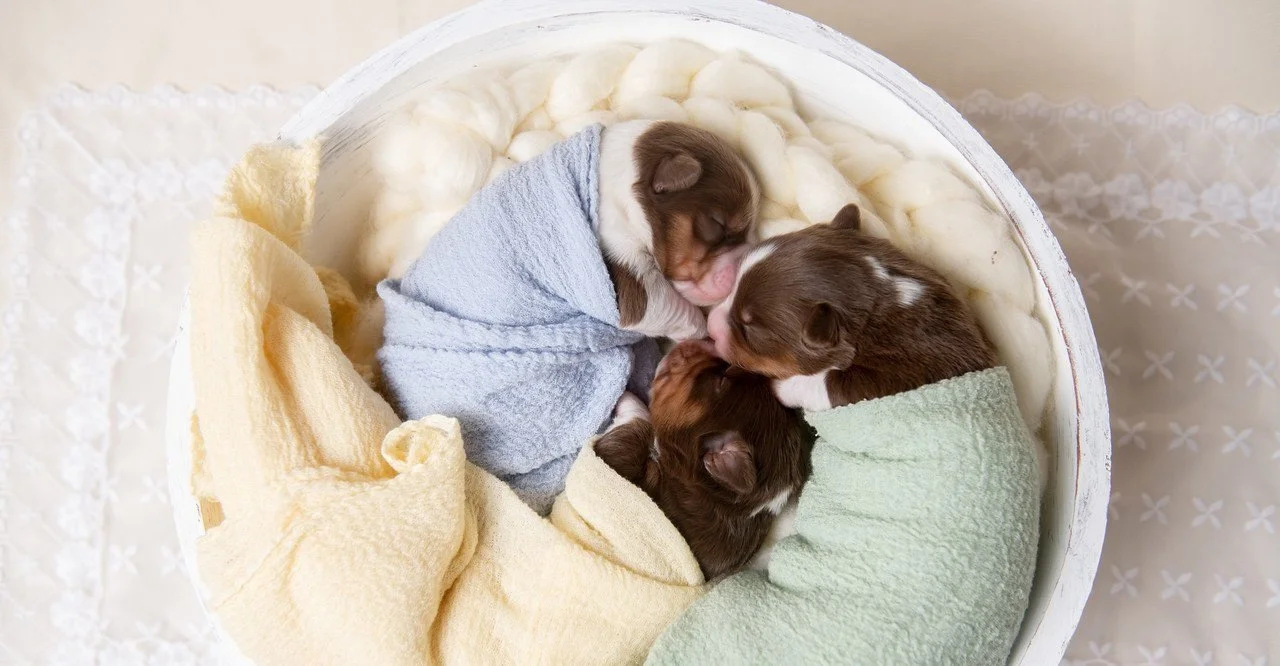
Purposeful Breeding.
Thoughtful Pairings.
Confident Puppies.
-
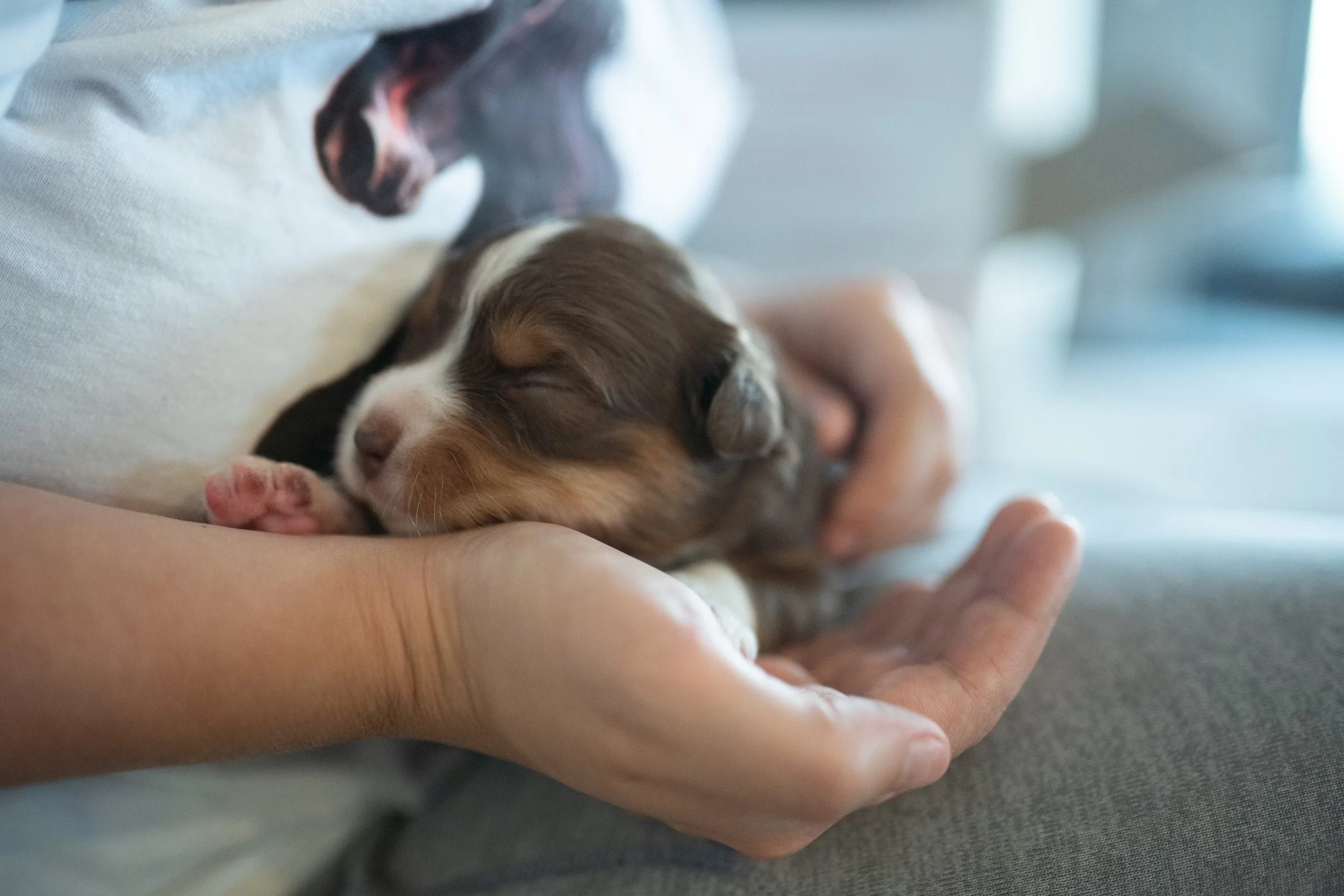
Our Breeding Philosophy
At Cleverest, our Mini American Shepherds are family first.
Our breeding program is rooted in a deep love for the breed and a commitment to producing healthy, confident, and versatile companions who can thrive in a variety of homes and disciplines. We breed sparingly and intentionally, focusing on preserving breed integrity, temperament, structure, and drive.
All of our breeding dogs have received their OFA (Orthopedic Foundation for Animals) evaluations for hips and elbows, have annual CAER eye clearances, and are genetically tested in accordance with the recommendations of the Miniature American Shepherd Club of the USA. All results are available for review. Our goal is to ensure the health, longevity, and well-being of every puppy we produce.
-

How We Raise Our Puppies
Our puppies are born and raised in our home, not in kennels or outbuildings. From birth, they are immersed in a stimulating, nurturing environment and receive early developmental support through Puppy Culture protocols and Early Neurological Stimulation.
They are introduced to a variety of age-appropriate sensory experiences: new surfaces, novel sounds, intentional scent work foundations, and safe social interactions with humans and other animals. As they grow, they explore new play environments, learn to interact with toys, and are introduced to crate and potty training. At six weeks, we begin separation and crate exposure in short intervals to prepare them for independence.
Our goal is to raise puppies who are confident, curious, and adaptable. Whether your future companion will be a sport dog, a family pet, a conformation competitor, or all of the above, the early foundation we provide supports lifelong success.
-
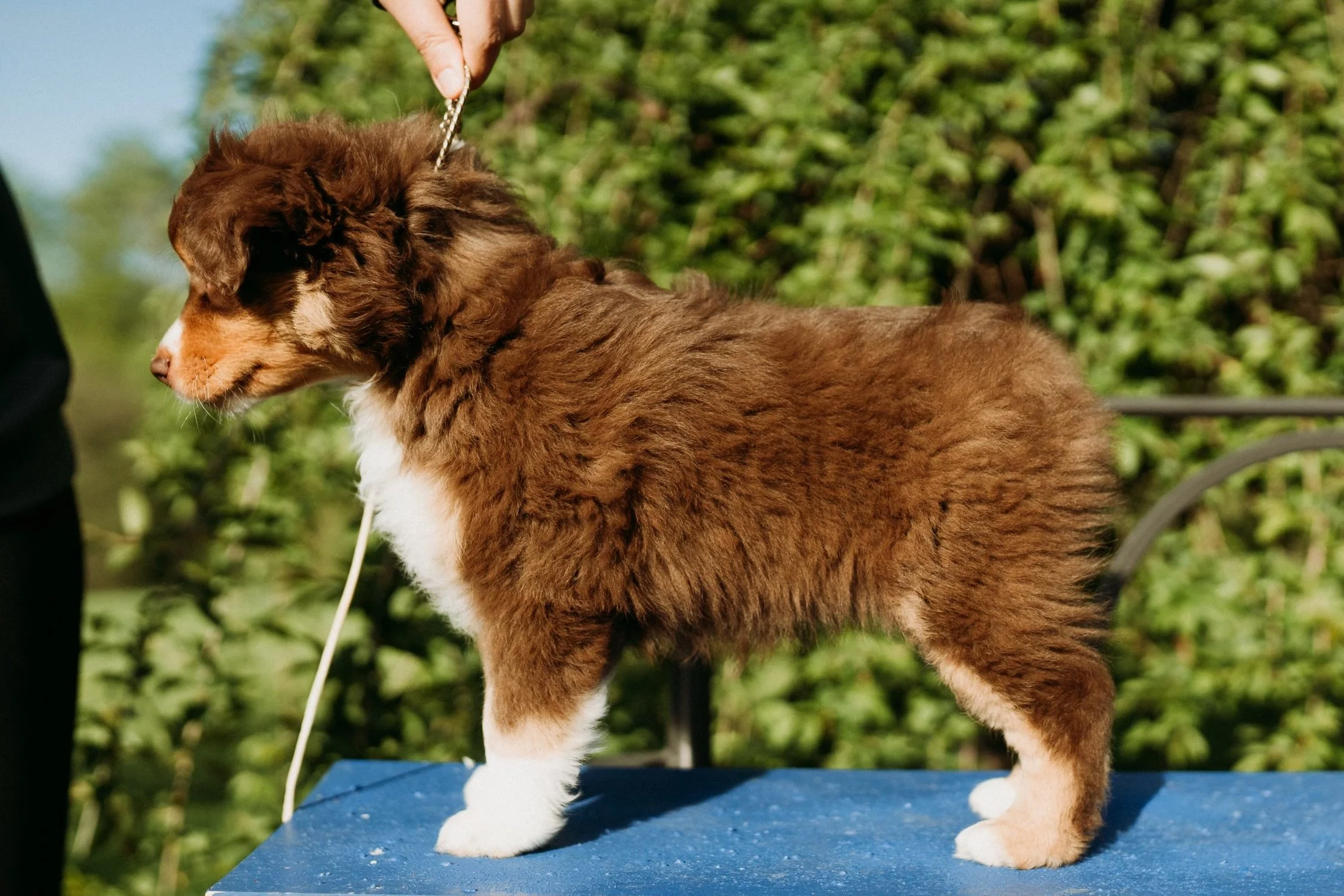
Matching Puppies to Homes
Puppies are not placed on a first-come, first-served basis.
Instead, we evaluate each puppy individually for temperament and structure and match them to the home that best suits their potential.
If you are looking for a performance or conformation dog, we will work closely with you to identify the right fit. If you’re looking for a loving companion, we’ll help you find the pup with the personality and energy level that aligns best with your lifestyle.
We consider your goals, family structure, preferences, and experience level when making matches. Puppy placements are made at eight weeks of age, and puppies go home between eight to ten weeks old.
-
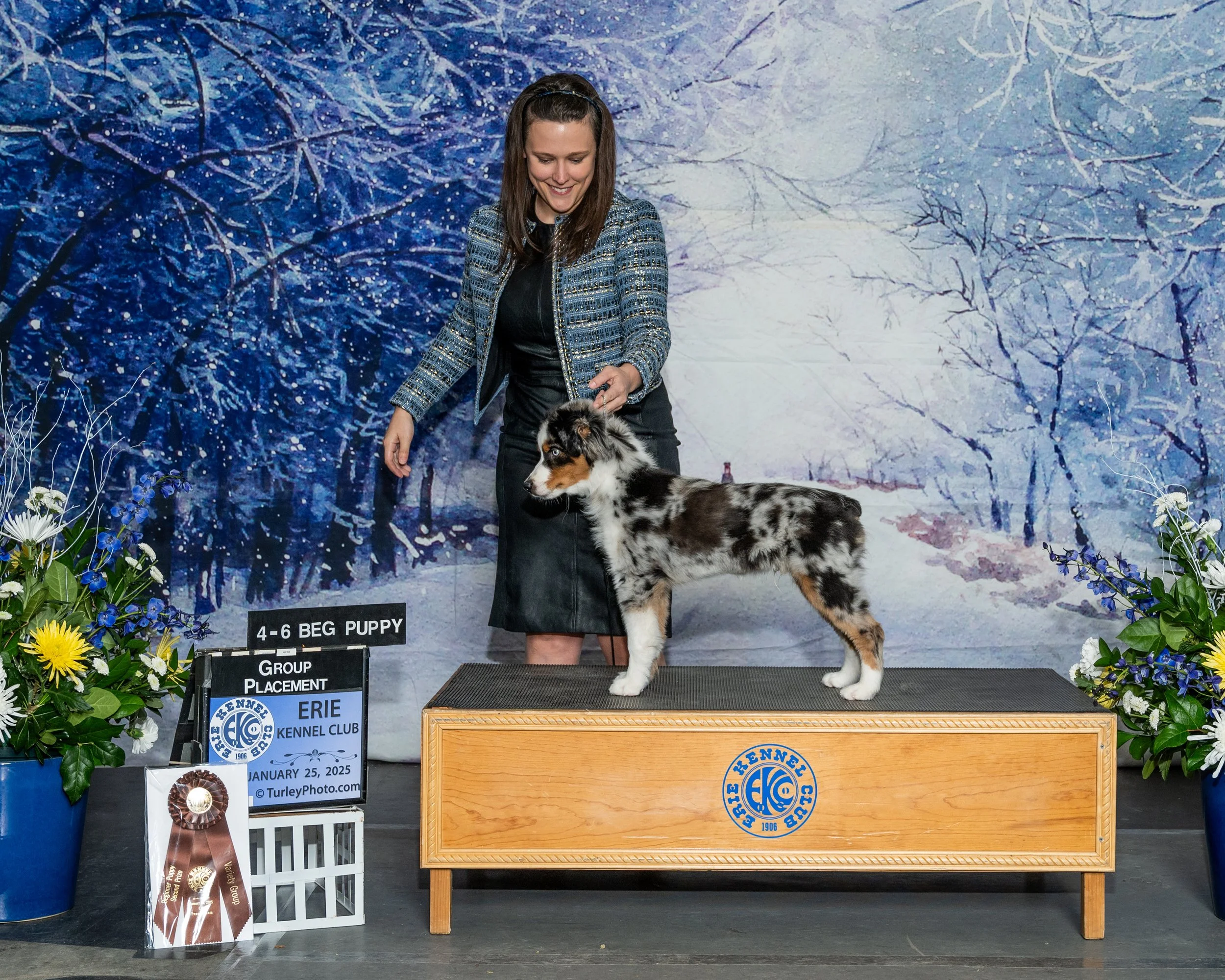
Companion vs Show Puppies
All of our puppies are bred to the AKC Miniature American Shepherd standard. You can read the standard on the MASCUSA website.
The difference between a "companion" and a "show" puppy is often minor and cosmetic such as a bit too much white, slightly incorrect ear set, etc.
Companion puppies are sold with limited registration and a spay/neuter contract that must be fufilled between 18-24 months old.
They can participate in all AKC sports and activities, just not in the conformation ring.
-
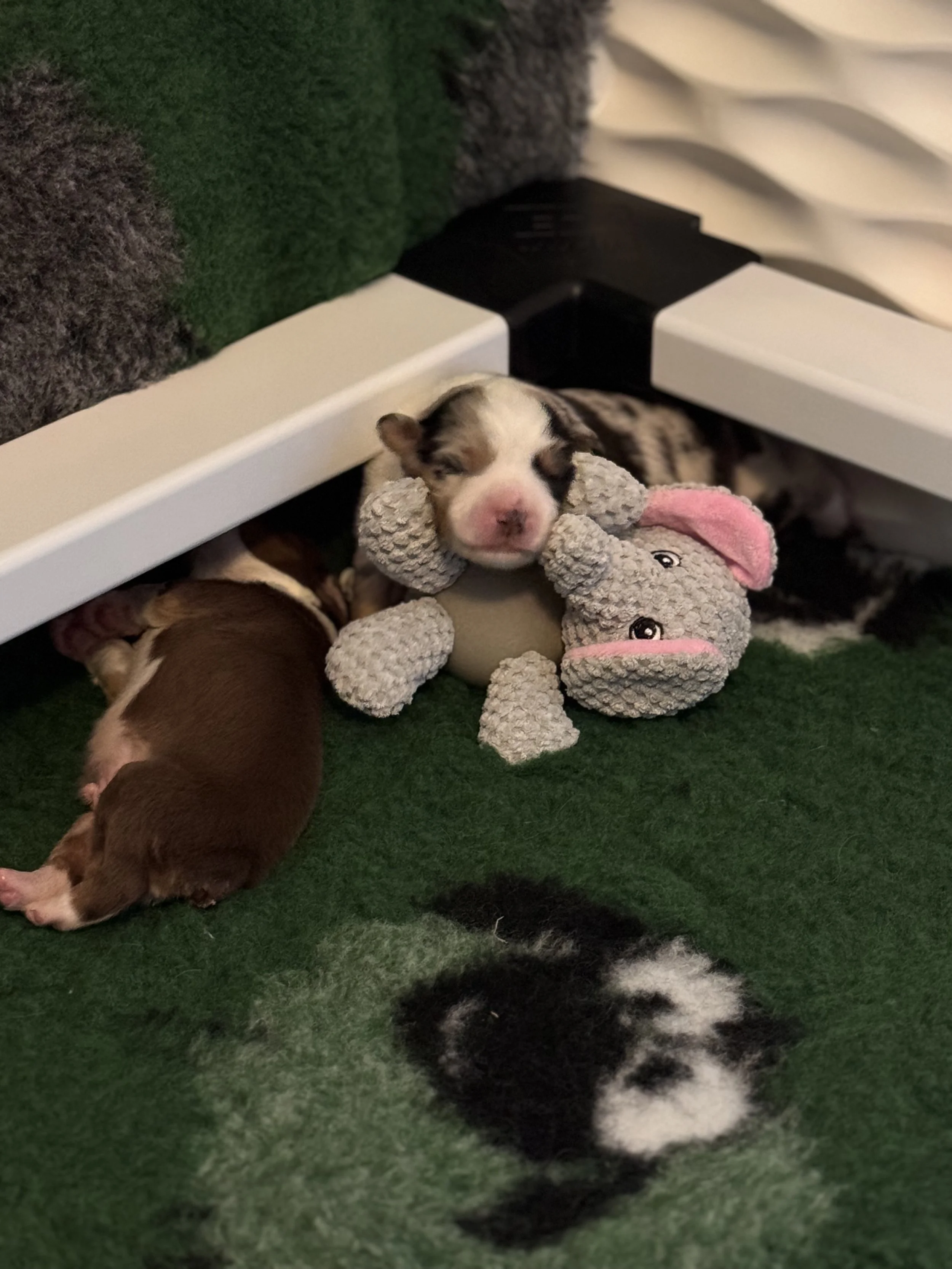
What Do Puppies Cost?
Each litter is priced individually based on a range of factors:
Health testing and breeding costs
Stud fees and veterinary care
Structure and temperament evaluationsOur pet puppies typically range from $1,800–$3,000, depending on evaluations. We breed on a limited basis and only when we’re looking to further our program.
Cleverest is not a business - it’s a labor of love.
Show and breeding prospects are available by private treaty and typically on co-ownership contracts.
-
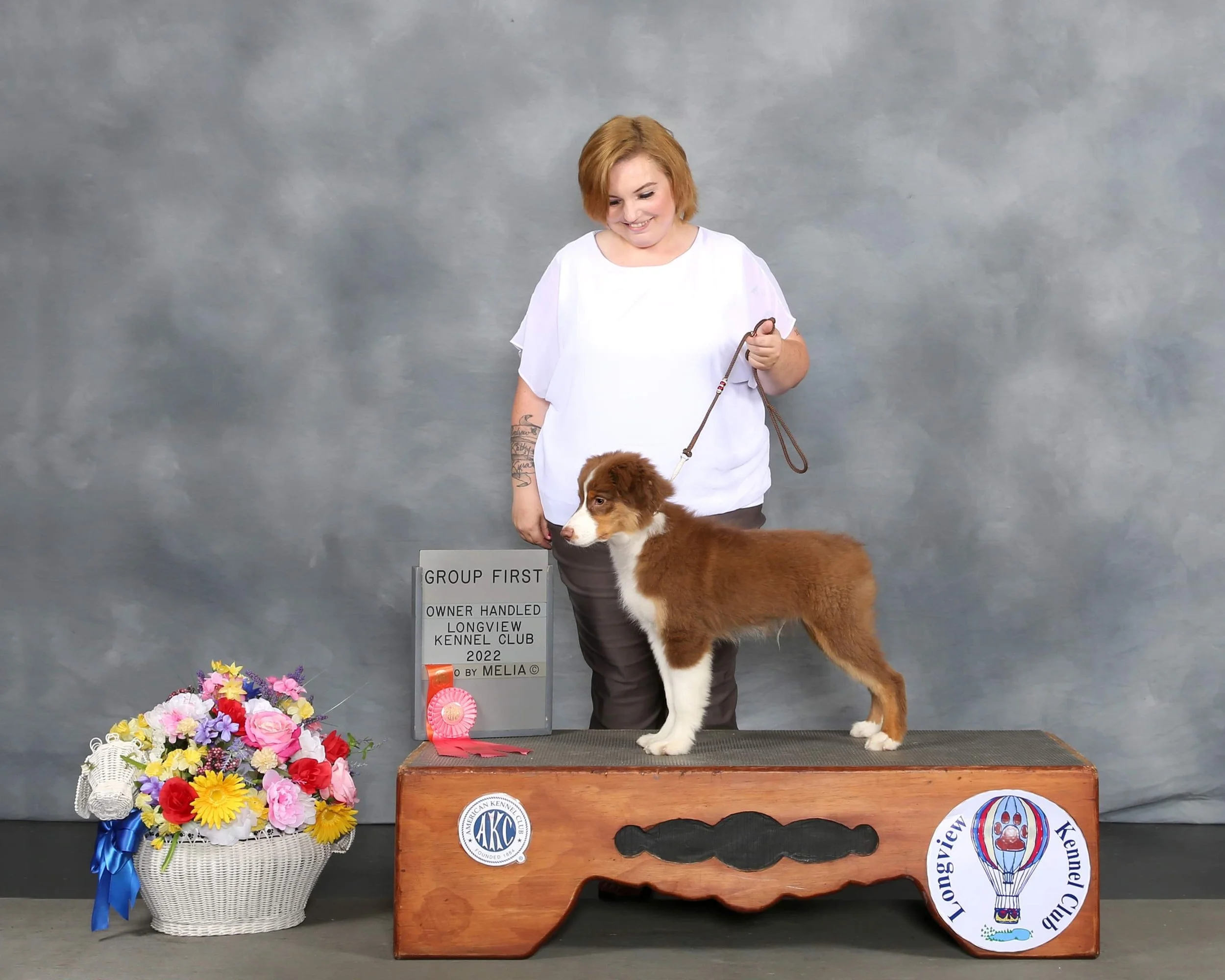
Our Co-Ownership Program
We occasionally place top prospects in co-ownership homes to ensure every dog lives a full, active life with individual attention and care. These dogs live with their families full-time while we retain breeding rights under clearly outlined agreements.
Each co-ownership is tailored, but typically:
Males remain intact and are made available for occasional stud use
Females may have 2 litters (with an optional third)
Health testing & breeding-related expenses are covered by CleverestWhen a dog is retired from breeding, full ownership transfers to the co-owner. This program helps us continue our vision without compromising the quality of life for our dogs.
PUPPY INFORMATION
Bringing home a new puppy is exciting, joyful, and (let's be honest) a little overwhelming. Below you'll find a collection of resources and guidance to help set you and your puppy up for success. From feeding and crate training to socialization and safety, my goal is to give you the tools you need for a smooth transition and a confident, well-adjusted dog.
That said, no list or page can cover everything. As your breeder, I am committed to each puppy I produce for their entire lifetime. I’m always just a text message or phone call away and happy to answer questions, troubleshoot challenges, or simply chat about how your Cleverest pup is doing, whether it’s the first week home or ten years down the road.
-
Your puppy will come home eating a high-quality kibble appropriate for growing puppies. We will send information about the specific brand and feeding schedule in your puppy’s go-home materials as well as some of their current kibble to get you started.
We recommend feeding your puppy three meals a day until around four months of age, at which point you may transition to twice-daily feedings. For each meal, provide around ½ to ¾ cup of kibble, adjusting for weight, age, and activity level. If your puppy is reluctant to eat, you can mix in a small amount of warm water or wet food to entice them. Do not leave food out. Feed meals at set times and remove uneaten food after 15 minutes. Always provide access to fresh, clean water.
Avoid feeding from your table to prevent begging behaviors. We also recommend avoiding pork products, raisins, grapes, chocolate, onions, and processed rawhides. Our preferred long-lasting chews include bully sticks, Benebones, and beef cheeks. These are great tools for enrichment and teething relief.
-
Your puppy has already been introduced to a crate by the time they go home. We recommend continuing this training immediately.
Choose a crate approximately 32"L for a growing puppy, scaling up to a 36" or 42”L crate for adult size. We suggest placing the crate near your sleeping area and using soft music to soothe your puppy at night. Puppies may only hold their bladder for four to five hours at eight weeks old. Take them out for potty breaks regularly and avoid giving water close to bedtime.
Encourage your puppy to settle by providing a safe chew toy or a small treat at bedtime. Do not let your puppy nap right before bed. Tire them out with play and short training sessions.
-
House training is an ongoing process, but the groundwork will already be laid when your puppy arrives. We recommend:
Frequent potty breaks, especially after eating, playing, or waking up
Supervision in a small, confined space
Praise and reward when your puppy goes potty in the correct location
Using a cue like “Go potty” to build association
Avoiding punishment. Redirect with a firm “no” and take them outside immediately
Puppies are typically familiar with litter box or potty pad training as a transition step. You can use this near the door and begin moving them outside as they improve.
-
Your puppy will have already experienced a wide range of sights, sounds, textures, and social interactions. Socialization continues at home and is especially important between 8 and 16 weeks.
Effective socialization does not mean forcing your puppy to interact with everything they encounter. In fact, the most valuable socialization involves exposing your puppy to new sights, sounds, and environments without pressure or forced engagement. For example, sitting calmly on a bench at a park while children play in the distance is a great way for your puppy to absorb new experiences in a low-pressure setting.
Too often, well-meaning owners unintentionally overwhelm their puppies by rushing the process or pushing them into interactions that make them uncomfortable. Instead, allow your puppy the choice to observe and engage at their own pace. Reward calm, curious behavior, and avoid overexposing them to situations where they feel unsafe or overstimulated. Our goal is to build confident dogs who feel secure in their surroundings and trust their handler to advocate for them.
Focus on quality over quantity. A few positive experiences are more beneficial than many overstimulating ones.
-
Introduce other household pets slowly and under supervision. It is recommended that the inital meeting takes place at a neutral site (not within your home). After that, use a crate or gate for initial interactions so they can safely observe each other. Reward calm behavior.
Puppies often try to engage in herding behaviors (nipping heels, barking). Interrupt these gently and redirect with a toy or treat.
-
Puppies chew to relieve teething discomfort and to explore. Provide safe, durable toys. We love frozen rope toys, Benebones, and puzzle feeders. If your puppy chews something inappropriate, redirect immediately and praise for chewing the right item.
Avoid soft plush toys with squeakers until your puppy is older or supervised. If you notice pieces missing, remove the toy.
-
Miniature American Shepherds are a herding breed and may instinctively nip or chase. You can discourage this by:
Redirecting to a toy or chew
Using a sharp “Ah ah!” or “No”
Stopping play and walking away briefly
Reinforcing calm interactions
This is normal behavior, but consistency is key. We are always happy to discuss training methods with you.
-
As a versatility-focused program, we actively encourage the development of toy drive in our puppies starting as early as possible. One of the most effective ways to build this is through structured tug play. Contrary to popular belief, tugging does not promote aggression when done thoughtfully. In fact, it builds engagement, confidence, and a love of working with people, which are qualities that are invaluable for sport and performance dogs. For breeds like Miniature American Shepherds, which are known to be "easy keepers," tugging can also be an excellent way to reinforce behaviors without over-reliance on food rewards.
Proper tugging is less about pulling and more about resistance. Your puppy should be pulling against you, not the other way around. We always encourage lateral movement, side to side, rather than up and down, to align with a dog’s natural biomechanics and avoid potential neck strain. Think of how dogs instinctively shake toys. When introducing tug, we gently apply resistance and engage with the puppy using soft touches to the head, neck, and body. This not only builds drive and focus but also lays a foundation for future training by normalizing contact and engagement during active play.
Our tug work is inspired by trusted sport dog trainers such as Susan Garrett and others who understand that tugging, when used as a relationship-building tool, can be one of the most powerful reinforcers in your training toolkit. When you pick up your puppy we’re happy to demonstrate proper and safe tugging techniques.
-
Puppy-proof your space. Keep items like medications, electrical cords, small objects, plants, and cleaning products out of reach. Puppies explore with their mouths, and prevention is the best way to avoid accidents.
Toxic foods and substances to avoid include:
Chocolate
Grapes and raisins
Onions and garlic
Alcohol and caffeine
Xylitol (found in sugar-free gum and peanut butter)
Cooked bones
Create a safe area (crate or playpen) where your puppy can rest without getting into trouble.
-
Puppies are sensitive to extreme temperatures. In the summer, ensure they have access to shade and clean water. Our red tri dogs have coats that are especially sensitive to sun exposure and can easily become “sun bleached” so we try to avoid long periods in the sun. In the winter, avoid long exposure to cold, ice, or salted sidewalks. Never leave a young puppy outside unsupervised.
Let’s Talk About Tails
One of the questions I’m asked most often is about tails; whether they’re allowed, why some Miniature American Shepherds have them, and what we do here at Cleverest.
According to the breed standard, a docked or natural bobtail is preferred. A docked tail should be straight and not exceed three inches. An undocked tail is permitted and may hang with a slight curve when at rest or raise with movement and excitement. While the breed standard still favors docked or naturally short tails, it’s important to note that tailed Mini Americans are allowed in the conformation ring, and we’re starting to see more tailed champions emerging, which is both exciting and encouraging for the future of our breed.
As a performance-focused program, I also recognize the functional value of a tail, especially in canine athletes. A tail contributes to a dog’s balance, agility, and movement. Studies and sports veterinarians note that tails act as a counterbalance, aiding dogs in making sharp turns, stabilizing during jumping and landing, and maintaining coordination during high-speed maneuvers. For active or sport-focused homes, this can be a real asset.
That said, tails are currently docked on most puppies in our program within the first 2 to 3 days of life, as is standard practice in the breed. At that age, it’s nearly impossible to reliably evaluate structure or potential, so most puppies will have docked tails.
However, we do not dock tails on puppies with disqualifying faults, such as:
White body splashes (a conspicuous, isolated white patch on the area between the withers and tail, or on the sides between elbows and hindquarters)
White covering more than 25% of an ear
In very specific and limited cases, we will leave a tail on a puppy for serious sport competitors. but this must be arranged in advance. In those cases, full payment is required before the puppy is 3 days old, and the payment is non-refundable due to the permanent nature of the decision.
If tails are something that’s especially important to you, I’m always happy to have that conversation early in the process.
UPCOMING LITTER PLANS
We are planning to breed Leviosa during her late summer or early fall heat cycle in 2026. While a stud has not yet been selected, this litter will be a collaborative effort with her co-owner, Kimberly Johnson of Dynasty Minis. The pairing will be carefully chosen with a focus on versatility; producing puppies that can excel in performance sports, conformation, and as confident, loving companions.
More details will be shared as plans are finalized. If you are interested in this litter, we recommend submitting a puppy application below to begin the conversation.
Interested In JOining The Cleverest Crew?
We’re so glad you’re here. Choosing a Miniature American Shepherd is a big decision, and we’re honored you’re considering a Cleverest puppy. Our application helps us get to know you; your lifestyle, your goals, and what kind of companion you’re looking for so we can make the best possible match.
We raise each puppy with love, intention, and a lifelong commitment to their well-being. This form is the first step in that journey together. Once we’ve had a chance to review your application, we’ll reach out to continue the conversation.
Please note: Cleverest Miniature American Shepherds is proudly inclusive and LGBTQ+ friendly, and we do not tolerate discrimination, bigotry, or hate in any form. Our puppies are placed only in homes that reflect the same care, respect, and empathy that we pour into our dogs every day. If you are aligned with these values, you are welcome here. If not, we’re not the breeder for you.
